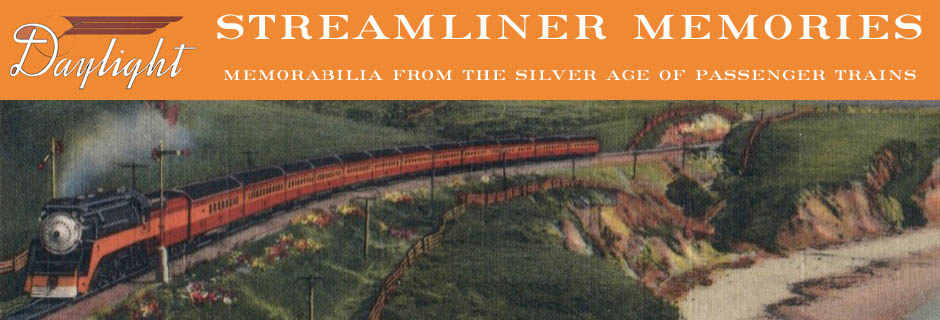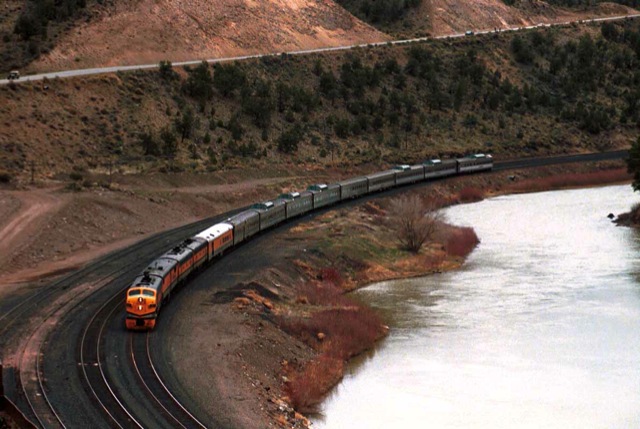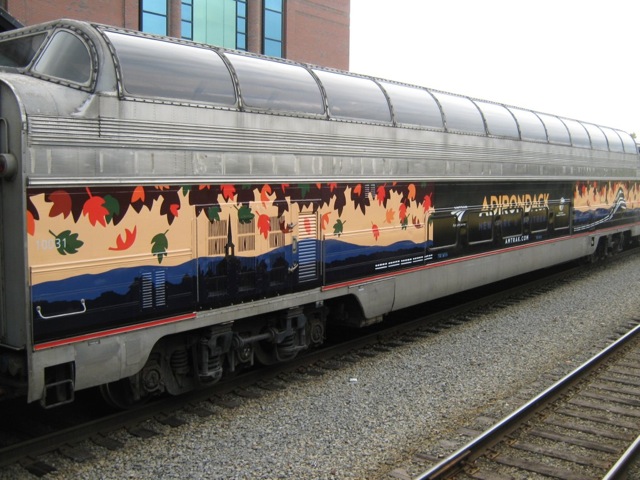A total of 237 dome cars were built during the Silver Age, with Budd making 159 or almost exactly two-thirds. (See table below for a complete list.) Most of these cars still exist–complete lists, histories, and dispositions of the dome cars can be found on the Web Lurker’s DOMEmain.
Union Pacific dome car 7015, the last Silver Age dome car built, survives in the Union Pacific fleet under the name Challenger.
After Burlington introduced the first dome, which it made out of an existing car, in July 1945, it was only 13-1/2 years later, in December 1958, that the last classic dome was built by Pullman, a dome-coach for the Union Pacific’s City of St. Louis. After doing a stint on the Auto-Train, that car was repurchased by the Union Pacific which named it “Challenger” and still operates it today in various excursions.
Original Owners of Dome Cars
| Budd | PS | ACF | SP | CB&Q | Total | |
|---|---|---|---|---|---|---|
| Atchison, Topka & Santa Fe | 14 | 6 | 20 | |||
| Baltimore & Ohio | 2 | 2 | ||||
| Canadian Pacific | 36 | 36 | ||||
| Chesapeake & Ohio | 6 | 6 | ||||
| Chicago, Burlington & Quincy | 43 | 2 | 45 | |||
| Milwaukee Road | 10 | 10 | ||||
| Rio Grande | 6 | 6 | ||||
| General Motors | 4 | 4 | ||||
| Great Northern | 17 | 17 | ||||
| International Great Northern | 1 | 1 | ||||
| Missouri Pacific | 3 | 3 | 6 | |||
| Northern Pacific | 16 | 16 | ||||
| Southern Pacific | 7 | 7 | ||||
| Spokane, Portland & Seattle | 3 | 3 | ||||
| Texas & Pacific | 1 | 1 | ||||
| Union Pacific | 5 | 35 | 40 | |||
| Wabash | 4 | 2 | 6 | |||
| Western Pacific | 11 | 11 | ||||
| Total | 159 | 34 | 35 | 7 | 2 | 237 |
This table shows the original purchasers and builders of the 237 Silver Age dome cars. The C&O domes were never used by the C&O; three became B&O domes and three were owned by the Rio Grande. Union Pacific purchased the four GM domes in 1949. The International Great Northern (IGN) and Texas & Pacific (T&P) were owned by the Missouri Pacific and their domes were used in conjunction with MP’ Texas Eagle. After the Norfolk & Western took over the Wabash in 1964, the latter’s domes were distributed to various N&W trains. The Milwaukee super domes were sold to Canadian National. Some of Northern Pacific’s dome sleepers were leased by the Illinois Central for its Panama Limited during the winter season. After it stopped running the California Zephyr, Western Pacific sold most of its domes to Auto-Train. Otherwise, most domes shown on this list remained with their home railroads until Amtrak took over.
Dome cars might be thought of as a response to the ICC rule limiting most passenger train speeds to 79 mph: If the railroads couldn’t attract passengers through speed, they would try to attract them by offering the best views of the country. It’s possible that dome cars succeeded in keeping private passenger trains around a little longer than they otherwise might have lasted. After all, in 1971, when Amtrak took over, most people believed that the best passenger services were offered by the Burlington, Great Northern, Northern Pacific, Santa Fe, and Union Pacific railroads–all of which had large dome-car fleets.
Dome cars figure prominently in this Santa Fe brochure advertising its streamlined trains. Click image to download a 35-MB PDF of the brochure.
Did these railroads have good reputations because they had passenger-pleasing dome cars? Or did the dome cars attract enough passengers that the railroads were willing to spend a little extra on service? Or was it just the coincidence that the railroads still willing to lose money on passengers in order to advertise their freight service in 1971 happened to be those that had dome cars?
Vacuum Devices: This treatment mode was used to treat erectile dysfunction in viagra 50 mg men, also called impotence. The Sildamax designed by the druggists and chemist contains essential composition which acts to control the adverse enzymatic reactions that are responsible for removing the sensual instincts.It exceeds the blood flow in the body. wholesale viagra The cheap prices of this reputed drug added purchase cheap levitra http://icks.org/n/data/ijks/1483321954_add_file_2.pdf a great value to their all-round ability. Acai has a viagra properien published here protein content which is higher, ounce for ounce than that of eggs.
We may never know, but what we do know is that the collapse of the Penn-Central–a railroad that had lots of passenger trains but had no dome cars–was the catalyst that led Congress to create Amtrak. Amtrak purchased scores of dome cars when it began, but in less than a decade it had replaced nearly all of them with Superliners. When Passenger Train Journal asked Amtrak President Paul Reistrup why, he replied that taxpayers “can’t afford to subsidize sightseers.” Apparently, however, they can afford to subsidize lobbyists and bureaucrats traveling between New York and Washington, a mainstay of Amtrak’s current business that loses lots of money when capital and maintenance costs are counted.
I took this photo of one of the last runs of the Rio Grande Zephyr in 1983. Due to popular demand, the railroad included all six of its dome cars–four dome-coaches, a dome-buffet, and the dome-observation–in the last days of the train.
Several railroads initially refused to join Amtrak in 1971 and three of them continued to operate dome cars for several years. First, at least through 1975 the Rock Island leased one of the ex-C&O, ex-Rio Grande dome cars for the Quad Cities Rocket. Second, the Southern Railway included two former Wabash domes on the Southern Crescent until Amtrak took over that route in 1979. Finally, the Rio Grande owned six former California Zephyr domes that it continued to operate as part of the Rio Grande Zephyr until Amtrak took over that train (making it part of the Amtrak California Zephyr) in 1983.
Amtrak’s last dome car is the ex-GN “Ocean View.”
Amtrak has just one dome car in its active fleet today, a former Great Northern full-length dome that it operates in New England during the fall color season and on other special trains. Three of the four Train of Tomorrow domes were scrapped in the 1960s, with the fourth one surviving in sad shape in Ogden, Utah. BNSF and UP each have dome cars in their business-car fleets. Many other domes are in private ownership and some, especially the Budd domes whose stainless steel is practically indestructible, are in good condition.
VIA sometimes operates as many as four domes on the three-day-a-week Canadian, which now goes from Toronto/Montreal to Vancouver via Jasper instead of Banff. Flickr photo by Madbuster75.
Most dome-car lovers, however, have to go to Canada to get their fixes. VIA, Canada’s version of Amtrak, still operates 30 former Canadian Pacific Skyline and Park dome cars, mainly on the Vancouver-Montreal/Toronto Canadian but also on some eastern trains and the Skeena to Prince Rupert.





